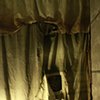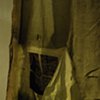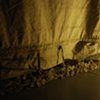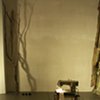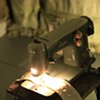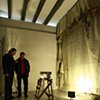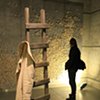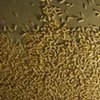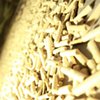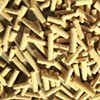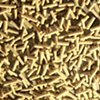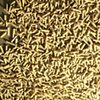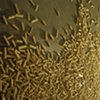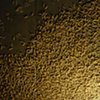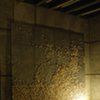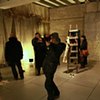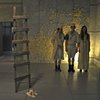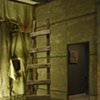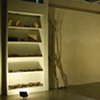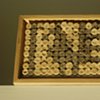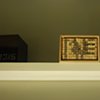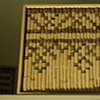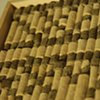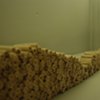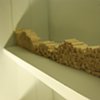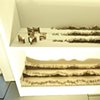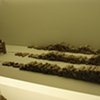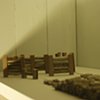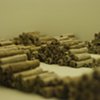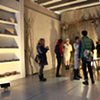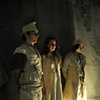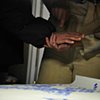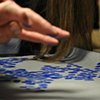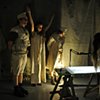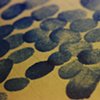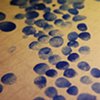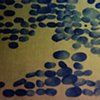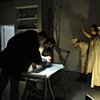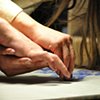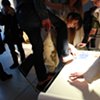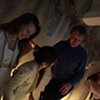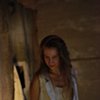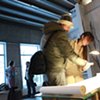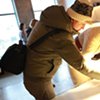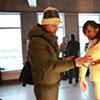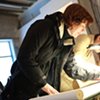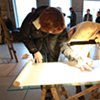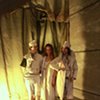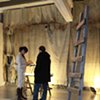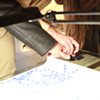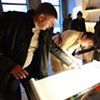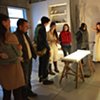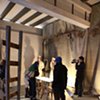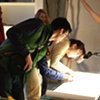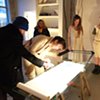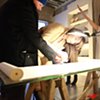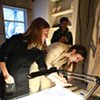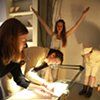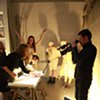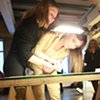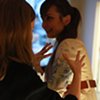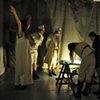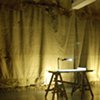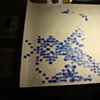
canvass [PHASE I / II]
Location: Gridchinhall, Moscow, Russia
PHASE I: December 17, 2011
PHASE II: January 21, 2012 with Tatiana Mazyar, Adam Leeds, Fedor Ivanov.
canvass [PHASE I]
At Gridchinhall, I butchered an old army tent that stood on the property for over 5 years and served in the Russian military prior to that. Its nearly destroyed condition attracted me as means to access the history accumulated in the fabric. Fragmenting this material into scrolls of various sizes, I created an archive of sorts that reflected my research on identity and eluded to the political climate in Russia at that time. Alongside the scrolls, I installed a ladder, which suspiciously stood on the floor. On it, hung a flannel caftan made from the second layer of the butchered army tent and at the foot of the latter, a pair of matching flannel house slippers anticipated an action. Also present in the exhibition space, a sewing machine perforated a loop of white ribbon, producing no stitch yet generating a continuous sound. These objects set up the condition of being in between, or being in the midst of. On the back wall, was draped the remainder of the army tent, which transformed the exhibition hall into what was simultaneously a stage and a backstage.
canvass [PHASE II]
On January 21, visitors were invited back to return for a participatory performance. While the installation served as a set and props for canvass [PHASE II] - Leave Your Trace, I asked the visitors to volunteer their fingerprints to be stamped by me onto a roll of rice paper. This drawing when complete, would become a blueprint for an embroidery pattern depicting a two headed eagle (a heraldic symbol of Russia), two Pava birds (a traditional Russian embroidery motif depicting a quail), and two women, one with her arms up, the other with her arms down. Each time a visitor's mark was deposited onto the roll of rice paper, my collaborators and I, dressed in the garments created from the last and innermost, cotton layer of the army tent, mimicked the imagery of the blueprint in progress: one woman raised her arms, and two men representing Pava birds bowed to the person leaving their mark.
Website photography: Tatiana Pronina, Tatiana Kozina, Denis Stegarev, Liliya Lifanova.
PHASE I: December 17, 2011
PHASE II: January 21, 2012 with Tatiana Mazyar, Adam Leeds, Fedor Ivanov.
canvass [PHASE I]
At Gridchinhall, I butchered an old army tent that stood on the property for over 5 years and served in the Russian military prior to that. Its nearly destroyed condition attracted me as means to access the history accumulated in the fabric. Fragmenting this material into scrolls of various sizes, I created an archive of sorts that reflected my research on identity and eluded to the political climate in Russia at that time. Alongside the scrolls, I installed a ladder, which suspiciously stood on the floor. On it, hung a flannel caftan made from the second layer of the butchered army tent and at the foot of the latter, a pair of matching flannel house slippers anticipated an action. Also present in the exhibition space, a sewing machine perforated a loop of white ribbon, producing no stitch yet generating a continuous sound. These objects set up the condition of being in between, or being in the midst of. On the back wall, was draped the remainder of the army tent, which transformed the exhibition hall into what was simultaneously a stage and a backstage.
canvass [PHASE II]
On January 21, visitors were invited back to return for a participatory performance. While the installation served as a set and props for canvass [PHASE II] - Leave Your Trace, I asked the visitors to volunteer their fingerprints to be stamped by me onto a roll of rice paper. This drawing when complete, would become a blueprint for an embroidery pattern depicting a two headed eagle (a heraldic symbol of Russia), two Pava birds (a traditional Russian embroidery motif depicting a quail), and two women, one with her arms up, the other with her arms down. Each time a visitor's mark was deposited onto the roll of rice paper, my collaborators and I, dressed in the garments created from the last and innermost, cotton layer of the army tent, mimicked the imagery of the blueprint in progress: one woman raised her arms, and two men representing Pava birds bowed to the person leaving their mark.
Website photography: Tatiana Pronina, Tatiana Kozina, Denis Stegarev, Liliya Lifanova.





